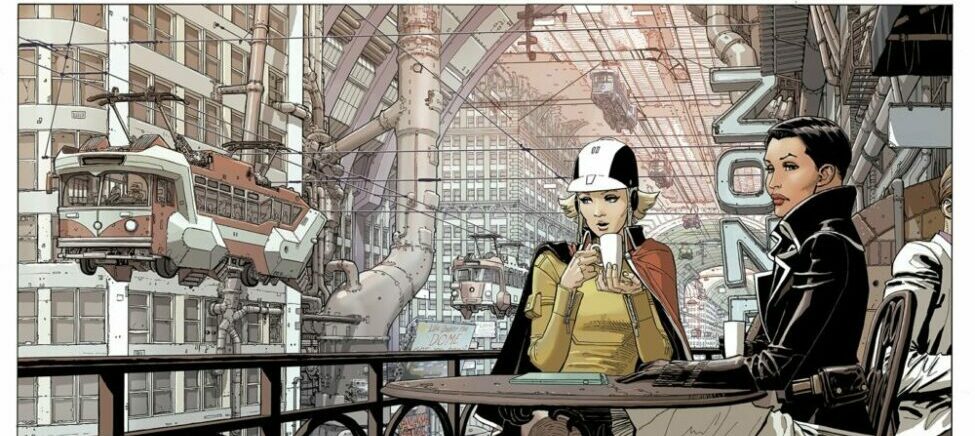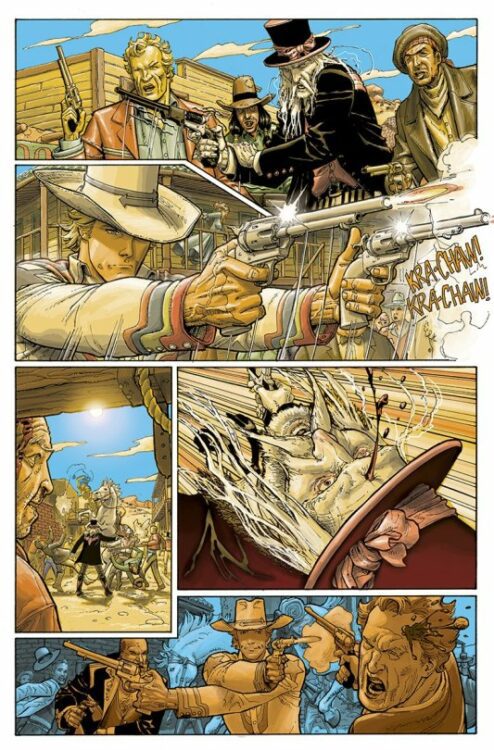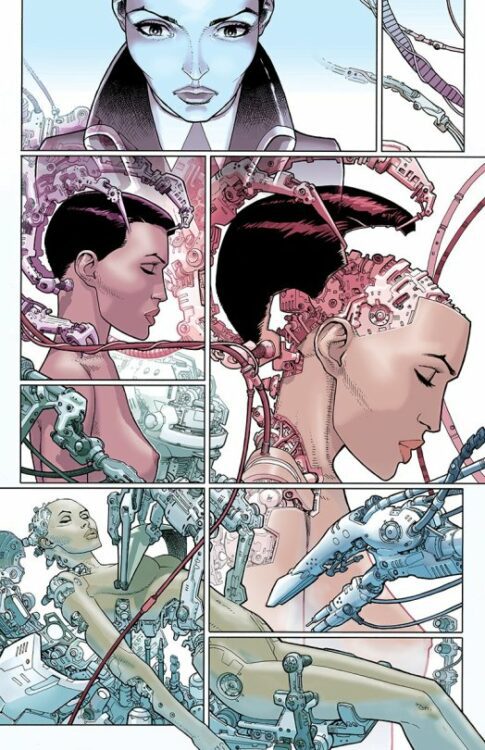Go back to the 1930s — the birth of the American comic book — and most of what you’ll find are anthologies. Characters beloved for generations started in titles like Action Comics, Whiz Comics, or Detective Comics. But those mainstream anthologies came from teams of creators, pumping out whatever they could to meet a monthly demand. One-man anthologies are more often relegated to the alternative scene. Dustin Weaver is a creator who has never firmly fit into either category. He has a definite love for genre and high concept, but without a focus on tight, punchy plots. His stories often start from a single image or concept that he explores page by page, piecing a narrative together alongside the readers. Paklis is Weaver’s solo anthology, created as a place for him to tell his own stories after years illustrating for Marvel. It’s been around six years since the last issue, but Paklis #6 has finally hit the stands with a guest contribution from writer Jeremy Barlow, making it a great time to go over the series’ unique appeal.

Paklis #6 is split into four separate stories. The first, “They’ll Bury You Where You Stand,” follows a Russian chosen for sacrifice in an off-kilter wild west town named “Pious Knife.” He seeks salvation in a mysterious stranger that’s blown in from out of town — and that’s almost what he gets. The second story, “1945 Part 2,” continues the tech-noir series from Paklis #5, with a deep-dive into detective work in the world of the future. “Sagitarus” offers two more pages to the ongoing Space Opera that’s been running since issue one, and then “Quitting Comics” wraps things up with an autobiographical story of what lead Weaver to create Paklis.
MFR ON YOUTUBE (latest video)
Help us reach 5K Subs!
“1945 Part 2” is the longest story in the anthology, taking up over half the page count. Where the original “1945” was a straightforward noir story with occasional cuts to strange sci-fi imagery, the second part focuses on the far future. The sudden shift means a lot of explaining up front to help readers find their feet before the later pages knock them back off balance. It all makes “1945” a kind of creative balancing act: a story that began from imagery Weaver found in a dream, where every attempt at explanation causes more questions and strange images to come bubbling to the surface. A push-and-pull between narrative and raw imagery. But progress is still being made, a bigger picture slowly coming together. A lot rides on how “1945” concludes in the next issue, but what’s come so far is one of the stand-out serials Paklis has to offer.
As for the cover story, “Pious Knife,” Jeremy Barlow’s assistance makes for a more traditional genre tale. Information is drip-fed page-by-page, with a final act twist to cap everything off. It’s a smart choice for an opener, giving a taste of what Weaver is capable of before slowing down the pace. The Wild West setting also offers a nice contrast to Paklis’ heavier sci-fi focus. Which doesn’t mean the story’s realistic or grounded. It’s still full of high concepts, just given a more mystical edge, like a gun that demands blood every twelve hours.

Weaver’s art is one of the main attractions of Paklis, both for its versatility and sheer sense of spectacle. An anthology is the perfect way for him to show off his range — from the dirty, wrinkled look of “Pious Knife” to the harsh shadows and zipatone of the past segments in “1945.” The one constant throughout the book is that, no matter the style, each page stays remarkably dense. Even when taking on a looser, cartoonier style for his self-deprecating autobiography, Weaver ups both the panel and word count, trading detailed backgrounds for rambling looks into his subconscious.
As for the colors, Weaver shifts the palette to suit each story’s tone. “Pious Knife” gets earthy tones offset by bright, garish clothing. “1945” switches frantically between a black-and-white past and a stark future, with different locations dominated by different tones, from an ominous red to cool blue and purple. “Sagitarus” gets greytones, while “Quitting Comics” spices up a monotone palette by focusing on bright orange.

Weaver’s lettering stays a bit more consistent throughout, relying on clear, all-caps lettering with a few bold words for flavor. It’s the sound-effects where he tries to get more creative, like a scratchy, hand-written “Ring-a-ling ling” for an alarm clock, or a translucent, humming “Dooooooom” to set the scene for a mechanical complex.
VERDICT
Paklis #6 keeps the series moving towards the future, feeling as if no time passed at all. Which for this issue, specifically is… more or less true. Weaver admits in the afterword that Paklis #6 had been finished back in 2018, but he wanted one more issue done before moving forward with publishing — which is why the first issue in quite a while doesn’t feel like a jumping-on point. But with Paklis coming out quarterly, there’s more than enough time to catch up. It’s out now from Image, so make sure to check it out. There’s nothing else on the stands quite like it.

